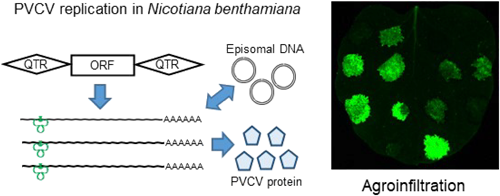- 著者
- Kazunori Kuriyama Midori Tabara Hiromitsu Moriyama Hideki Takahashi Toshiyuki Fukuhara
- 出版者
- Japanese Society for Plant Biotechnology
- 雑誌
- Plant Biotechnology (ISSN:13424580)
- 巻号頁・発行日
- pp.22.1017a, (Released:2022-12-08)
- 参考文献数
- 31
Petunia vein clearing virus (PVCV) is a type member of the genus Petuvirus within the Caulimoviridae family and is defined as one viral unit consisting of a single open reading frame (ORF) encoding a viral polyprotein and one quasi-long terminal repeat (QTR) sequence. Since some full-length PVCV sequences are found in the petunia genome and a vector for horizontal transmission of PVCV has not been identified yet, PVCV is referred to as an endogenous pararetrovirus. Molecular mechanisms of replication, gene expression and horizontal transmission of endogenous pararetroviruses in plants are elusive. In this study, agroinfiltration experiments using various PVCV infectious clones indicated that the replication (episomal DNA synthesis) and gene expression of PVCV were efficient when the QTR sequences are present on both sides of the ORF. Whereas replacement of the QTR with another promoter and/or terminator is possible for gene expression, it is essential for QTR sequences to be on both sides for viral replication. Although horizontal transmission of PVCV by grafting and biolistic inoculation was previously reported, agroinfiltration is a useful and convenient method for studying its replication and gene expression.
1 0 0 0 OA Structural features of T-DNA that induce transcriptional gene silencing during agroinfiltration
- 著者
- Emi Iida Kazunori Kuriyama Midori Tabara Atsushi Takeda Nobuhiro Suzuki Hiromitsu Moriyama Toshiyuki Fukuhara
- 出版者
- Japanese Society for Plant Biotechnology
- 雑誌
- Plant Biotechnology (ISSN:13424580)
- 巻号頁・発行日
- vol.40, no.4, pp.289-299, 2023-12-25 (Released:2023-12-25)
- 参考文献数
- 29
Agrobacterium tumefaciens (Rhizobium radiobacter) is used for the transient expression of foreign genes by the agroinfiltration method, but the introduction of foreign genes often induces transcriptional and/or post-transcriptional gene silencing (TGS and/or PTGS). In this study, we characterized the structural features of T-DNA that induce TGS during agroinfiltration. When A. tumefaciens cells harboring an empty T-DNA plasmid containing the cauliflower mosaic virus (CaMV) 35S promoter were infiltrated into the leaves of Nicotiana benthamiana line 16c with a GFP gene over-expressed under the control of the same promoter, no small interfering RNAs (siRNAs) were derived from the GFP sequence. However, siRNAs derived from the CaMV 35S promoter were detected, indicating that TGS against the GFP gene was induced. When the GFP gene was inserted into the T-DNA plasmid, PTGS against the GFP gene was induced whereas TGS against the CaMV 35S promoter was suppressed. We also showed the importance of terminator sequences in T-DNA for gene silencing. Therefore, depending on the combination of promoter, terminator and coding sequences on T-DNA and the host nuclear genome, either or both TGS and/or PTGS could be induced by agroinfiltration. Furthermore, we showed the possible involvement of three siRNA-producing Dicers (DCL2, DCL3 and DCL4) in the induction of TGS by the co-agroinfiltration method. Especially, DCL2 was probably the most important among them in the initial step of TGS induction. These results are valuable for controlling gene expression by agroinfiltration.
- 著者
- Kazunori Kuriyama Midori Tabara Hiromitsu Moriyama Hideki Takahashi Toshiyuki Fukuhara
- 出版者
- Japanese Society for Plant Biotechnology
- 雑誌
- Plant Biotechnology (ISSN:13424580)
- 巻号頁・発行日
- vol.39, no.4, pp.405-414, 2022-12-25 (Released:2022-12-25)
- 参考文献数
- 31
Petunia vein clearing virus (PVCV) is a type member of the genus Petuvirus within the Caulimoviridae family and is defined as one viral unit consisting of a single open reading frame (ORF) encoding a viral polyprotein and one quasi-long terminal repeat (QTR) sequence. Since some full-length PVCV sequences are found in the petunia genome and a vector for horizontal transmission of PVCV has not been identified yet, PVCV is referred to as an endogenous pararetrovirus. Molecular mechanisms of replication, gene expression and horizontal transmission of endogenous pararetroviruses in plants are elusive. In this study, agroinfiltration experiments using various PVCV infectious clones indicated that the replication (episomal DNA synthesis) and gene expression of PVCV were efficient when the QTR sequences are present on both sides of the ORF. Whereas replacement of the QTR with another promoter and/or terminator is possible for gene expression, it is essential for QTR sequences to be on both sides for viral replication. Although horizontal transmission of PVCV by grafting and biolistic inoculation was previously reported, agroinfiltration is a useful and convenient method for studying its replication and gene expression.


